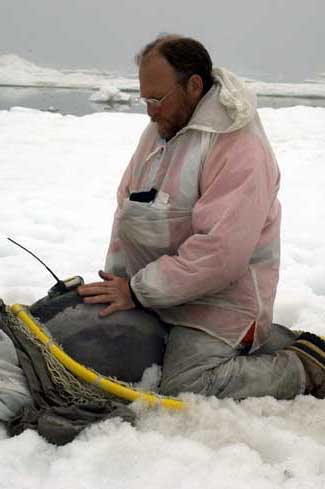 October 11, 2005
"We are analyzing the data to learn about the seasonal migrations, foraging behavior, and haul-out locations of ribbon seals ," said Dr. Michael Cameron, a wildlife biologist in the Polar Ecosystems Program at the Alaska Fisheries Science Center's National Marine Mammal Laboratory. "We are taking some of the initial steps towards developing the basic understanding required for the assessment and management of this poorly-understood species." Dr. Cameron explained that the Russian site was particularly favorable for capture and tagging studies because ribbon seals are found there in high densities within range of small Russian charter boats. Researchers captured ten seals in hoop nets on ice floes along the eastern coast of the Kamchatka Peninsula and glued recorders to their backs. The recorders, which transmit information to a satellite when the seals are at the surface or hauled out, are expected to remain glued to the two adult males, three adult females, and five pups for about 11 months. Researchers at the Alaska Fisheries Science Center receive the data from a satellite data-processing service called Argos, and archive them for analysis. "Ribbon seals are likely to be a key ecological component of arctic marine ecosystems, and they are one of four species of true seals that are subsistence resources for Alaska Native coastal communities in the Arctic." said Dr. Cameron. "The densities of ice-dwelling seals, along with walrus, are highly sensitive to suitable sea ice conditions, and therefore these species may be particularly vulnerable to climatic change." Some researchers have speculated
that most ribbon seals remain in the open ocean of the Bering
Sea in the summer. Data from this study so far supports the theory
that these seals remain primarily in the ice-free areas south
of the Bering Strait during summer. Most seals dispersed southeastward
from the Kamchatka area after they were tagged, with some adults
traveling into the North Pacific and foraging south of the central
Aleutian Islands. Most of the seals' dives were less than 150 meters deep (perhaps to the sea floor) when the seals were over the continental shelf, but the dives deepened as the seals moved offshore. Dr. Cameron said that the study has already demonstrated the feasibility of future studies on ribbon seals in the remote marginal ice zones of the central Bering Sea, an area that could be accessed by the new NOAA research vessel Oscar Dyson, which is homeported in Kodiak, Alaska.
On the Web:
Source of News & Photo:
Publish A Letter on SitNews Read Letters/Opinions Submit A Letter to the Editor
|
||
